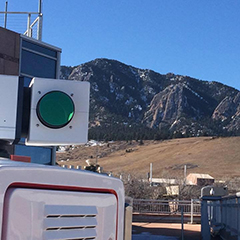Renewable NRG Systems, a designer and manufacturer of decision support tools for the global renewable energy industry, announced today the recent sale of two WINDCUBE 200S 3D Scanning Doppler Lidars to the National Oceanic and Atmospheric Administration (NOAA).
WINDCUBE 200S Lidars incorporate advanced techniques to measure the wind components on a large scale for short term campaigns or long term operations to reduce wind flow modeling uncertainties, understand physical phenomena such as wakes, and improve wind forecasting. They are able to perform a full 3D mapping of the atmosphere to provide remote measurements of wind speed, direction, turbulence, and boundary layer height.
The two machines will be utilized by NOAA’s Chemical Sciences Division for a variety of measurement purposes, starting with the XPIA experiment at the Boulder Atmospheric Observatory (BAO) taking place in April 2015. The XPIA Experiment is a field campaign that aims to quantify uncertainties in Doppler Lidar measurements of wind conditions. The project is being conducted with funding from the Department of Energy (DOE). For this experiment, multiple Doppler Lidar systems are being deployed in close proximity to the BAO’s heavily instrumented 300 m meteorological tower. Measurements of wind speed, wind direction, and velocity variance from well-calibrated sonic anemometers at six levels on the tower will be compared to measurements from the Doppler Lidars in order to assess the level of Lidar measurement bias and uncertainty.
Later this year, The WINDCUBE Lidars will be deployed for the Wind Forecast Improvement Project (WFIP 2), another research campaign aiming to improve NOAA’s short-term weather forecast models with regards to wind condition predictions that impact wind energy generation.



























